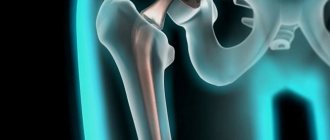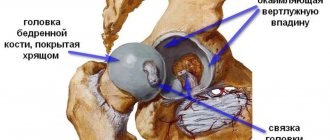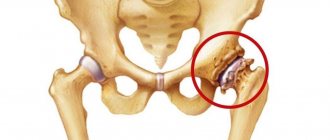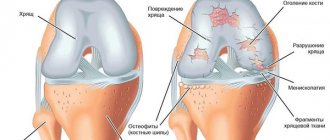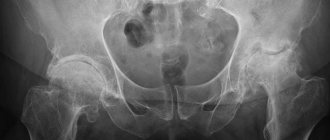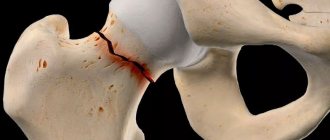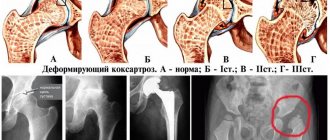Coxarthrosis of the hip joint 1st degree is an early stage of the disease, which is characterized by deformation of cartilage and bone and is accompanied by episodic pain. If the pathology is not treated, it can progress and lead to limitations in the musculoskeletal system.
Coxarthrosis of the 1st degree is characterized by unexpressed symptoms against the background of gradual destruction of the joint
Coxarthrosis is one of the most common diseases of the musculoskeletal system, which can occur against the background of other pathological conditions. The disease begins to develop gradually in old age (after 40 years), without pronounced symptoms, without affecting a person’s ability to work.
Due to the destruction of the cartilage and bone tissue of the hip joint, pain occurs after physical activity (running, walking, etc.).
Possible consequences:
- decreased performance: in 60% of cases;
- disability: 11.5%;
- need for surgical intervention (arthroplasty): 80%.
Causes
Coxarthrosis can be primary and secondary.
Primary osteoarthritis can develop due to excessive physical activity
The primary form of the disease occurs in the presence of risk factors, which may include:
- physical activity (running, walking);
- excess weight;
- metabolic and circulatory disorders in the joint, including diabetes mellitus, osteoporosis;
- injuries;
- heredity - the risk of development increases in people whose relatives suffered from arthrosis;
- joint inflammation - arthritis;
- stressful conditions.
Thus, with prolonged experiences and stress, the level of corticosteroid hormones in the blood increases, which leads to a decrease in the synthesis of hyaluronic acid, an important component of joint fluid.
The secondary form occurs against the background of diseases of the hip joint. These include:
- hip dysplasia;
- congenital form of hip dislocation;
- hip and pelvic injuries;
- inflammatory processes of infectious origin;
- aseptic necrosis;
- Perthes disease.
Also, depending on the location of the pathological process, coxarthrosis can be right-sided, left-sided or bilateral.
Coxarthrosis ( arthrosis of the hip joint ) is a type of deforming arthrosis of the joints, which is a chronic non-inflammatory disease that affects the hip joints (one or both at the same time). This disease is degenerative-dystrophic in nature. This means that the cartilage that forms the hip joint undergoes degenerative changes, thereby changing the surfaces of the bones. Next, bone growths (osteophytes) form, joint deformation occurs, the range of motion in the affected joint decreases, and they become extremely painful and uncomfortable.
The hip joint is one of the largest joints in our body. It is thanks to him that a very important motor function is performed in the human body, and he is also responsible for ensuring that our body is capable of movement. If the hip joint becomes ill, then this affects the entire body as a whole and prevents a person from living peacefully, walking, not to mention playing sports. Very often we see older people who are forced to rely on a cane due to a disease of the hip joint.
Despite the fact that the hip joint is extremely massive and strong, at the same time it is quite vulnerable, especially over time. Painful hip joints significantly reduce a person’s quality of life.
Coxarthrosis (arthrosis of the hip joint)
firmly ranks second among arthrosis of the joints in terms of the frequency of diagnosed cases after gonarthrosis (arthrosis of the knee joint).
CLASSIFICATION OF COXARTHROSIS (ARTHROSIS OF THE HIP JOINT)
There is coxarthrosis
both primary and secondary.
- The cause of primary coxarthrosis is mainly the inevitable wear and tear of the hip joints during life, and usually affects people after 40 years of age.
- The causes of secondary coxarthrosis are usually the following diseases: congenital femoral dislocation, damage by necrotic masses of the hip bone in the area of its head, Peters disease, trauma to the previously hip joint, inflammatory diseases of the hip joint. In this case, arthrosis of the hip joint
can affect either one joint separately or both.
There are several types of coxarthrosis:
- Dysplastic (is a congenital pathology and is characterized by underdevelopment of the joint).
- Involutive (typical for older people and associated with age-related changes).
- Post-infectious (preceded by purulent or purulent-allergic, rheumatoid arthritis).
- Disease due to Peters disease (development of osteochondropathy in the head of the femur).
- Coxarthrosis
due to trauma (fractures of the neck and head of the bone (femur)). - Coxarthrosis due to metabolic disorders (metabolism).
- Dishormonal (taking glucocorticosteroids, antidepressants for a long time).
- Idiopathic (the cause of which could not be determined).
SYMPTOMS OF COXARTHROSIS (ARTHROSIS OF THE HIP JOINT)
In order to correctly describe the symptoms of coxarthrosis, the stages of the disease should be considered at the same time, because the symptoms depend on the stage of the disease.
STAGES OF COXARTHROSIS (ARTHROSIS OF THE HIP JOINT)
In total, there are three stages of coxarthrosis (arthrosis of the hip joint):
- 1st stage of coxarthrosis. This is the initial stage of the disease, in which the symptoms are still mild. The joint at this stage does not hurt much and pain occurs only after physical activity, such as lifting heavy objects or jogging or hiking long distances. After the person rests, the pain disappears. The patient may also experience lameness if, for example, he walks more than two kilometers. Climbing up stairs increases the pain. The motor volume of the joint decreases slightly or remains unchanged. X-ray examination can show only slight changes in the bone structures.
- 2nd stage of coxarthrosis. This stage develops in the absence of treatment for the first stage. Added to the above symptoms is a specific crackling sound in the joint. The pain becomes more intense and begins to radiate to the groin area, and can also spread to the hip and knee. At this stage, not only strong, but also any movements can cause pain symptoms, even a slight load on the hip joint. Even getting out of bed or twisting your body can cause pain. Tension of the periarticular muscles occurs, which does not go away even at night, so patients often complain that the hip hurts at night. A person can begin to limp even after short walks (up to 500 meters). At this stage, the disease already forces a person to rely on a cane when walking. Restriction of movement in the joint becomes more pronounced. Based on the results of X-ray diagnostics, developing osteophytes are determined.
- Stage 3 coxarthrosis. The final stage of the disease. At this stage, the pain becomes permanent and torments the patient. Any movement, even the slightest, increases pain symptoms several times. At this stage, the hip joint is completely immobilized. Muscle mass in the thigh and buttocks decreases due to muscular dystrophy, which is very noticeable. Characteristic is the impossibility of the patient standing straight; the body will be skewed. Any arthrosis leads to the formation of contracture (flexion position); in this case, contracture is also formed due to the fact that the muscle fibers are in constant tension, while the leg on the affected side becomes shorter. As a result of the fact that the hip joint is immobilized, the entire leg ceases to perform its motor function, which has a very negative effect and leads to osteochondrosis. In addition, the spine also suffers, and sensations of discomfort and pain appear in the sacral region.
CAUSES OF COXARTHROSIS (ARTHROSIS OF THE HIP JOINT)
The main causes of coxarthrosis:
- Age-related changes in the joint. Typical for older people. The hip joint wears out over time, stops performing its functions over time, and “dries out,” which leads to a decrease in its shock-absorbing function and friction of the bones that form the joint against each other.
- Injury to the hip joint. The most common injury among people in this age category is a fracture of the femoral neck, which can lead to disability if not fully treated. A joint can be injured at any age, but older people are more likely to suffer.
- Impaired metabolism. This is typical for people with a history of metabolic disorders and diseases associated with impaired metabolism.
- Violation of hormonal status. This is more common in women, especially those who have been taking antidepressants and glucocorticosteroids for a long time.
- Hereditary anomalies of the development of the musculoskeletal system, as well as congenital anomalies. Unfortunately, today, a fairly large number of children are born with congenital pathologies of the musculoskeletal and nervous systems. As for developmental anomalies of the hip joint, this includes dysplasia, in which several structures of the joint do not develop.
- Arthritis of a systemic nature. Damage to several joints can also lead to damage to the hip joint. In this case, one of the main risk factors will be the presence of an inflammatory process.
- Rheumatic conditions and chronic arthritis. All this can also lead to hip pain. Such diseases that cause pain in the joint being studied include:
- rheumatism;
- rheumatoid arthritis;
- spondyloarthropathy;
- juvenile rheumatoid arthritis.
RISK GROUP FOR COXARTHROSIS (ARTHROSIS OF THE HIP JOINT)
The main risk group can include the following categories of people and harmful factors:
- Older people. This disease is typical for older people, elderly people, because degeneration processes occur that occur precisely in this age period.
- Female. Statistically, women are more susceptible to hip problems.
- People who are overweight or obese.
- Previous injuries to one or both hip joints.
- Hereditary predisposition to this type of disease and congenital anomalies of the hip joint.
- The presence in the past of infectious lesions, such as abscesses, aseptic necrosis of the head of the hip bone, osteomyelitis, and so on.
- Hard physical labor.
- Summer residents whose risk of developing coxarthrosis is extremely high.
PREVENTION OF COXARTHROSIS (ARTHROSIS OF THE HIP JOINT)
The main measures for the prevention of coxarthrosis are as follows:
- Dosed physical activity. It is important to do gymnastics and stretch the joint to prevent the development of pathological processes in it and slower aging. This will help not only improve the condition of the hip joint, but also the whole body.
- If there are metabolic disorders, they should be corrected. To do this, you should contact a specialist.
- Watch your weight. Do not forget that the hip joint already bears a large load, almost the entire body, so you should not interfere with it performing its functions. In addition, a lot of weight will put so much pressure on the joints that they will gradually collapse. People who are overweight are also susceptible to metabolic disorders.
- Avoid sharp turns of the body, especially if you are not warmed up and prepared, this will prevent you from injuring the head and neck of the femur.
- It is better, of course, to choose a sport in which joint injuries are least dangerous, for example, swimming or yoga, especially if there are hereditary predispositions or developmental abnormalities.
- A predisposition to joint diseases implies careful handling of them, as well as regular visits to the doctor in order not to miss the possible development of a disease or any other pathological process in the joint.
- If a child is diagnosed with hip dysplasia, it should be treated, and immediately! It is better for the child to be immobilized for several weeks at an early age than to suffer for the rest of his life.
- Timely treatment of infectious diseases, especially those that threaten to spread to the hip joint.
DIAGNOSIS OF COXARTHROSIS (ARTHROSIS OF THE HIP JOINT)
When diagnosing coxarthrosis, it is very important to find the cause that caused it. After all, as we have already discussed above, there are many reasons, they are diverse, and treatment of arthrosis of the hip joint
, accordingly, will differ radically. Sometimes it is not so easy, and sometimes it is completely impossible. The emphasis is on studying the manifestations of the disease and selecting appropriate treatment.
First of all, the patient is carefully interviewed by the doctor, studying in detail the complaints, causes of the disease, hereditary burden, the presence of injuries, and so on. It is very important to have the complaints described above and how long the patient has had them.
After the interview, the doctor personally examines the affected area for the presence of inflammatory changes, trophic changes, deformities, shortening of limbs, asymmetries, and so on. And in children there may be a “clicking” symptom.
An important point is additional examination methods - computer and magnetic resonance imaging, ultrasound and x-ray examination, because they will help make the final diagnosis. In the differential diagnosis of coxarthrosis from other diseases of the hip joint, this point is extremely important.
Symptoms of coxarthrosis of the hip joint 1st degree
Depending on the symptoms, the development of coxarthrosis is divided into three stages. The main symptom of the disease is severe pain in the hip, groin and knee joint.
The characteristic symptom of the disease is pain
Coxarthrosis of the 1st degree is characterized by the appearance of periodic pain in the patient as a result of various types of physical activity. The pain is localized in the hip joint and can also spread to the hip and knee. After rest, the pain goes away.
In grade 1 disease, an x-ray of the hip joint can reveal uneven narrowing of the joint space and proliferation of bone tissue in the area of the acetabulum. Changes in the neck and head of the femur are not observed.
With grade 1 coxarthrosis, the patient does not have:
- restrictions in movement: disturbances when walking or running;
- changes in muscle strength.
Modern views on the origin and pathogenesis of coxarthrosis
Coxarthrosis is a polyetiological disease that develops for various reasons. Nosological characteristics, features of the clinical and functional manifestation and course of the disease are determined by post-traumatic, infectious, dystrophic, involutive and other types of joint lesions.
The following triggers for the development of the disease are known:
- Excessive overloads of the upper pole of the femoral head (non-physiological loads), which by themselves or along with other causes lead to severe dystrophic and ischemic lesions of the structural articular elements and a general disruption of the biomechanics of the musculoskeletal system;
- Bacterial and tissue-specific sensitization of the body to antigens of supporting tissues;
- Stressful and unfavorable environmental factors.
The basis and essence of the mechanism of development of coxarthrosis is a violation of the blood supply to the articular elements. In all cases, it inevitably leads to the destruction of the bone, cartilage and soft tissue structures of the hip joint. At the same time, compensatory-adaptive reactions are activated, aimed at recreating the destroyed articular elements. Despite the variety of causes of coxarthrosis, they fit into 4 causal models:
- Internal causative factors – dysplasia (genetically mediated developmental abnormalities of the hip joint);
- Extreme external influences, including environmental ones;
- Organismal factors - systemic diseases (rheumatism, gout, collagenosis), metabolic disorders, allergies;
- Involutive processes, which are considered as physiological metabolic-dystrophic, sluggishly flowing diseases accompanied by chronic infections.
Rheumatologists at the Yusupov Hospital first establish the cause of coxarthrosis, then prescribe treatment.
Diagnosis of the disease
When diagnosing, clinical symptoms of the disease, examination and radiography data are taken into account. Functional tests are also used to determine the range of movements, determine the length of the limbs in order to identify their shortening.
An X-ray of the pelvis is usually performed to make the diagnosis.
X-ray of the pelvis is one of the instrumental methods that allows you to determine the degree of development of coxarthrosis. If necessary, other diagnostic methods can be used:
- computed and magnetic resonance imaging (CT and MRI);
- ultrasound examination (ultrasound).
CT makes it possible to study pathological changes in bone tissue, while MRI and ultrasound make it possible to assess the condition of cartilage tissue in the hip joint.
Mechanism of development of coxarthrosis
As is known from human anatomy, the hip joint is formed by the femur and ilium. The first has a head that connects to the acetabulum of the second like a hinge. Thanks to this articulation, we can move the leg in different directions (forward, backward and sideways), as well as rotate.
During all these manipulations, the bones are not damaged against each other thanks to the cartilage tissue that completely covers the articular surfaces. It also acts as a shock absorber, softening the force of impact while walking. Inside the joint cavity is filled with a special fluid, which increases the sliding of cartilage relative to each other and is also responsible for their nutrition. This anatomical formation is delimited from the external environment by a capsule, which ensures its integrity and protects it from mechanical damage.
Hip mechanism
With coxarthrosis, the intra-articular fluid becomes thick and viscous, which is why the hyaline cartilage does not receive enough nutrients. It dries and becomes covered with microcracks, the gap between the articular surfaces decreases, as a result of which they are injured against each other during movement. Over time, the cartilage tissue becomes thinner and the bones become deformed. Changes at this stage are irreversible.
Treatment of coxarthrosis of the hip joint 1st degree
Treatment is complex and conservative:
- drug therapy;
- massage;
- therapeutic exercise (physical therapy);
- mud therapy;
- traditional methods;
- surgical intervention.
Drug treatment
The main goal of drug treatment is to relieve severe pain and inflammation, and regenerate cartilage tissue without surgery. To normalize blood circulation, relieve spasms of the thigh muscles and restore cartilage tissue, drugs with different mechanisms of action are used.
Drug therapy is selected by the attending physician
Warming ointments/compresses with antispasmodics are indicated to relieve pain. Nonsteroidal anti-inflammatory drugs (NSAIDs) are prescribed, but long-term use of these drugs may slow down the repair of cartilage damage.
To eliminate cartilage deformations in grade 1 coxarthrosis, chondroprotectors are used - drugs that contain chondroitin sulfate or glucosamine.
They stimulate the process of regeneration of cartilage tissue and the formation of joint fluid, prevent the destruction of articular cartilage, and also have an anti-inflammatory effect.
Chondroitin sulfate is a mucopolysaccharide that takes part in the formation of cartilage and bone tissue and has anti-inflammatory and analgesic properties.
Non-drug methods of treating the initial stage of arthrosis
At the initial stage of development of the disease, treatment with folk remedies helps.
Natural therapy using natural remedies will not help cure arthrosis of the hip joint, but it is perfect as a component of complex therapy to improve tissue trophism and relieve pain.
Before using folk remedies, you should definitely consult a doctor and exclude the possibility of allergic reactions to the components of traditional medicines. Tinctures and rubs based on cinquefoil , bay leaf, sunflower roots, garlic, lemon, red hot pepper, and celery root have proven themselves well in the treatment of arthrosis. Massage for arthrosis gives a positive effect if it is performed regularly by a highly qualified specialist.
A specialist prescribes a set of therapeutic gymnastic exercises, and he must be present during the first two procedures to monitor the correct implementation of the complex and the correct load on the joints.
Disease prevention
Measures to prevent the development of coxarthrosis include maintaining a healthy, active and active lifestyle, regular exercise to strengthen muscles and joints, and weight control.
As a preventive measure for older people, doctors recommend:
- follow the principles of healthy eating;
- exercise;
- take a course of massage treatments;
- visit the pool;
- do Norwegian walking or skiing;
- undergo sanatorium-resort treatment;
- take chondroprotective drugs once a year.
Features of treatment
Basic principles of treatment:
1. Restoring blood supply to the joints. Swelling and muscle spasms form around the diseased joint, which impairs blood circulation in the bursa, impairing the production of synovial fluid. That is why, with coxarthrosis, it is important to first relieve swelling and restore blood flow. Manual osteopathic techniques can successfully cope with this.
2. Increase in physical activity. Only in such cases will the synovial fluid be able to properly wash the cartilage, the cells will receive normal nutrition and be able to regenerate. Exercises should be careful and careful. Performing exercises through force and pain is prohibited, otherwise the joint will be further destroyed and the rate of development of coxarthrosis will increase. For this purpose, our clinic successfully uses methods of physical therapy and kinesiotherapy in general.
3. Lifestyle changes in general. It is not recommended to lift weights, sit or stand for long periods of time. The diet should contain products that provide the cartilage tissue of the hip joint with the necessary elements - fluorine, magnesium, phosphorus.
By following these rules, you can achieve cartilage restoration and slow down the progression of grade I and II coxarthrosis. With grade III coxarthrosis, the chances of treatment success largely depend on the patient’s perseverance: good results are quite achievable if the patient himself is committed to serious work. The main task is to preserve the original hip joint. Osteopathy and exercise therapy successfully cope with it.
The most common reason for visiting a doctor is pain in the hip joint, as well as a feeling of stiffness.
In such cases, an examination by an osteopathic doctor will be mandatory. Osteopathy has been included in the list of medical specialties since 2015 as the highest degree of training for a specialist in manual therapy.
The need to start treatment with an osteopath is due to the fact that pain, and the disease itself in principle (especially in the initial stages) is often caused by chronic overload of the hip joint due to an imbalance in the axial balance of the body in combination with tension in the periarticular tissues and muscles. As a result, the hip takes a physiologically incorrect position or is compressed, and the articular elements are overloaded. Pain occurs.
During the examination, the osteopath will determine a shift in the center of gravity to one of the legs, areas of bone overload in the hip joint, impaired mobility in the joint and the location of anatomical structures, which are often the true causes of coxarthrosis.
